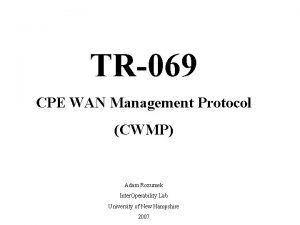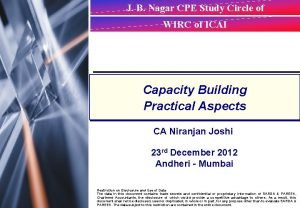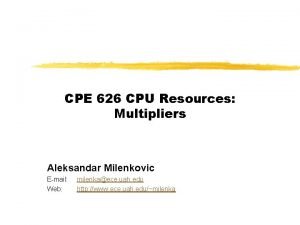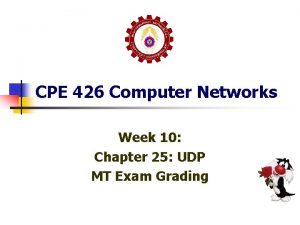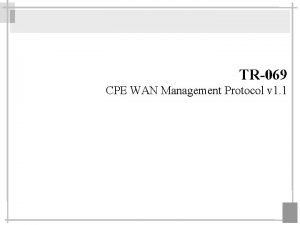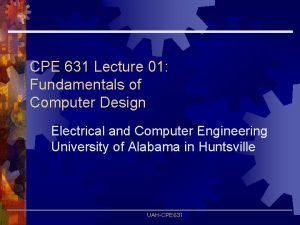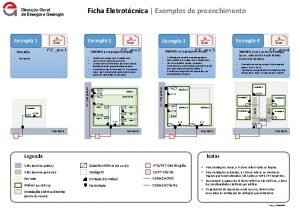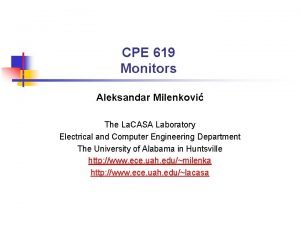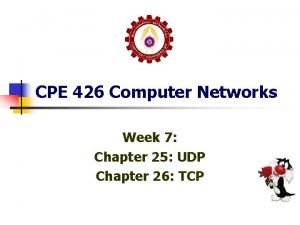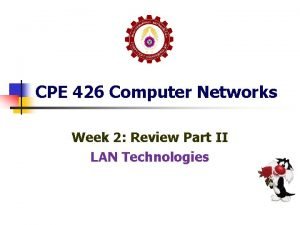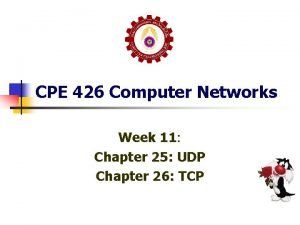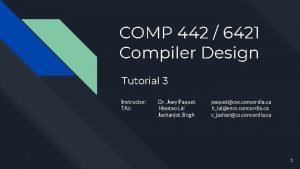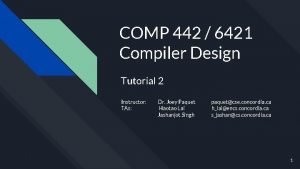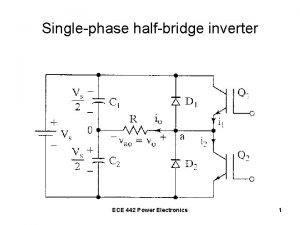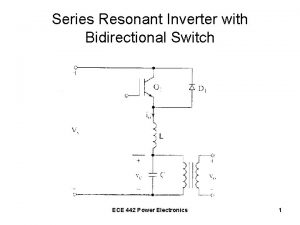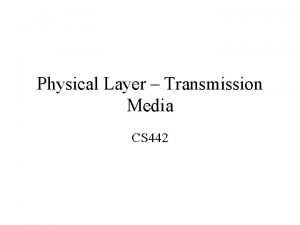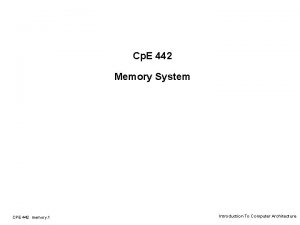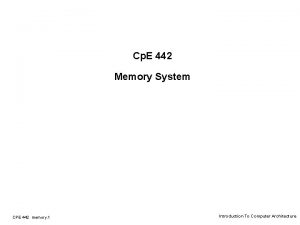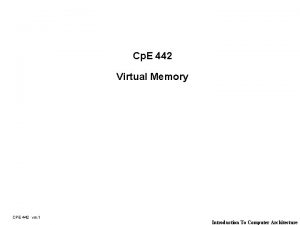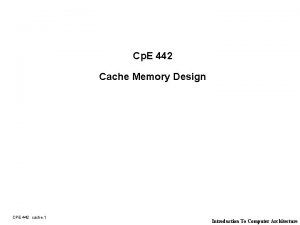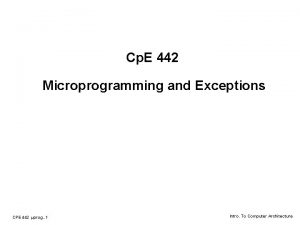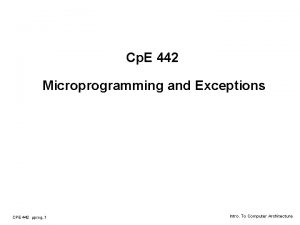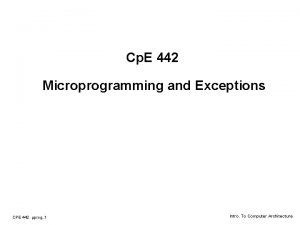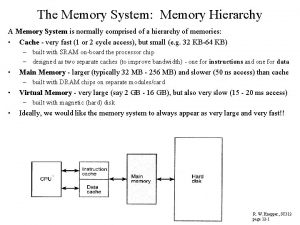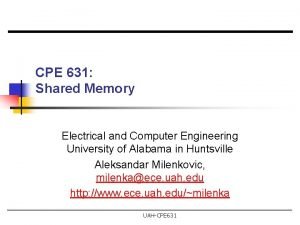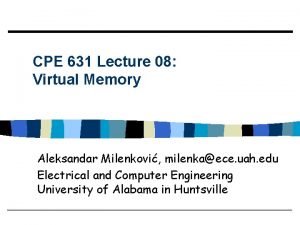Cp E 442 Memory System CPE 442 memory





































- Slides: 37

Cp. E 442 Memory System CPE 442 memory. 1 Introduction To Computer Architecture

Recap: Solution to Branch Hazard Cycle 1 Cycle 2 Cycle 3 Cycle 4 Cycle 5 Cycle 6 Cycle 7 Cycle 8 Clk 12: Beq Ifetch Reg/Dec Exec (target is 1000) 16: R-type Ifetch Reg/Dec 20: R-type Ifetch 24: R-type Mem Wr Exec Mem Wr Reg/Dec Exec Mem Wr Ifetch Reg/Dec Exec Mem 1000: Target of Br Wr ° In the Simple Pipeline Processor if a Beq is fetched during Cycle 1: • Target address is NOT written into the PC until the end of Cycle 4 • Branch’s target is NOT fetched until Cycle 5 • 3 -instruction delay before the branch take effect ° This Branch Hazard can be reduced to 1 instruction if in Beq’s Reg/Dec: • Calculate the target address • Compare the registers using some “quick compare” logic CPE 442 memory. 2 Introduction To Computer Architecture

Recap: Solution to Load Hazard Cycle 1 Cycle 2 Cycle 3 Cycle 4 Cycle 5 Cycle 6 Cycle 7 Cycle 8 Clock I 0: Load Ifetch Plus 1 Reg/Dec Exec Mem Wr Ifetch Reg/Dec Exec Mem Plus 2 Plus 3 Plus 4 Wr ° In the Simple Pipeline Processor if a Load is fetched during Cycle 1: • The data is NOT written into the Reg File until the end of Cycle 5 • We cannot read this value from the Reg File until Cycle 6 • 3 -instruction delay before the load take effect ° This Data Hazard can be reduced to 1 instruction if we: • Forward the data from the pipeline register to the next instruction CPE 442 memory. 3 Introduction To Computer Architecture

Outline of Today’s Lecture ° Recap and Introduction (5 minutes) ° Memory System: the BIG Picture? (15 minutes) ° Memory Technology: SRAM and Register File (25 minutes) ° Memory Technology: DRAM (15 minutes) ° A Real Life Example: SPARCstation 20’s Memory System (5 minutes) ° Summary (5 minutes) CPE 442 memory. 4 Introduction To Computer Architecture

The Big Picture: Where are We Now? ° The Five Classic Components of a Computer Processor Input Control Memory Datapath Output ° Today’s Topic: Memory System CPE 442 memory. 5 Introduction To Computer Architecture

An Expanded View of the Memory System Processor Control Memory Datapath Speed: Fastest Size: Smallest Cost: Highest CPE 442 memory. 6 Memory Slowest Biggest Lowest Introduction To Computer Architecture

The Principle of Locality ° The Principle of Locality: • Program access a relatively small portion of the address space at any instant of time. ° Two Different Types of Locality: • Temporal Locality (Locality in Time): If an item is referenced, it will tend to be referenced again soon. • Spatial Locality (Locality in Space): If an item is referenced, items whose addresses are close by tend to be referenced soon. CPE 442 memory. 7 Introduction To Computer Architecture

Memory Hierarchy: Principles of Operation ° At any given time, data is copied between only 2 adjacent levels: • Upper Level: the one closer to the processor - Smaller, faster, and uses more expensive technology • Lower Level: the one further away from the processor - Bigger, slower, and uses less expensive technology ° Block: • The minimum unit of information that can either be present or not present in the two level hierarchy To Processor Upper Level Memory Lower Level Memory Blk X From Processor CPE 442 memory. 8 Blk Y Introduction To Computer Architecture

Memory Hierarchy: Terminology ° Hit: data appears in some block in the upper level (example: Block X) • Hit Rate: the fraction of memory access found in the upper level • Hit Time: Time to access the upper level which consists of RAM access time + Time to determine hit/miss ° Miss: data needs to be retrieve from a block in the lower level (Block Y) • Miss Rate = 1 - (Hit Rate) • Miss Penalty: Time to replace a block in the upper level + Time to deliver the block the processor ° Hit Time << Miss Penalty To Processor Upper Level Memory Lower Level Memory Blk X From Processor CPE 442 memory. 9 Blk Y Introduction To Computer Architecture

Memory Hierarchy: Performance and Cost Let h be the probability of a hit ti access time of level I, Average access time = h t 1 + (1 -h) t 2, approx = t 1 with h close to 1 (0. 9999) Let ci be the capacity of level i Let coi be the cost per bit of level i Ave cost per bit = (c 1*co 1+c 2*co 2)/ (c 1+c 2), approx= co 2, since c 1 << c 2 and co 1 >> co 2 Access time close to fastest memory, with low cost CPE 442 memory. 10 Introduction To Computer Architecture

Memory Hierarchy: How Does it Work? ° Temporal Locality (Locality in Time): If an item is referenced, it will tend to be referenced again soon. • Keep more recently accessed data items closer to the processor ° Spatial Locality (Locality in Space): If an item is referenced, items whose addresses are close by tend to be referenced soon. • Move blocks consists of contiguous words to the upper levels To Processor Upper Level Memory Lower Level Memory Blk X From Processor CPE 442 memory. 11 Blk Y Introduction To Computer Architecture

Memory Hierarchy of a Modern Computer System ° By taking advantage of the principle of locality: • Present the user with as much memory as is available in the cheapest technology. • Provide access at the speed offered by the fastest technology. Processor Control Speed (ns): 1 s Size (bytes): 100 s CPE 442 memory. 12 On-Chip Cache Registers Datapath Second Level Cache (SRAM) 10 s Ks Main Memory (DRAM) 100 s Ms Secondary Storage (Disk) 10, 000 s (10 s ms) Gs Introduction To Computer Architecture

Memory Hierarchy Technology ° Random Access: • “Random” is good: access time is the same for all locations • DRAM: Dynamic Random Access Memory - High density, low power, cheap, slow - Dynamic: need to be “refreshed” regularly • SRAM: Static Random Access Memory - Low density, high power, expensive, fast - Static: content will last “forever” ° “Non-so-random” Access Technology: • Access time varies from location to location and from time to time • Examples: Disk, tape drive, CDROM ° The next two lectures will concentrate on random access technology • The Main Memory: DRAMs • Caches: SRAMs CPE 442 memory. 13 Introduction To Computer Architecture

Random Access Memory (RAM) Technology ° Why do computer designers need to know about RAM technology? • Processor performance is usually limited by memory bandwidth • As IC densities increase, lots of memory will fit on processor chip - Tailor on-chip memory to specific needs - Instruction cache - Data cache - Write buffer ° What makes RAM different from a bunch of flip-flops? • Density: RAM is much more denser CPE 442 memory. 14 Introduction To Computer Architecture

Technology Trends Capacity Logic: 2 x in 3 years Speed 2 x in 3 years DRAM: 4 x in 3 years 1. 4 x in 10 years Disk: 1. 4 x in 10 years 2 x in 3 years DRAM CPE 442 memory. 15 Year 1980 1983 1986 Size 64 Kb 256 Kb 1 Mb Cycle Time 250 ns 220 ns 1989 1992 1995 4 Mb 16 Mb 64 Mb 165 ns 145 ns 120 ns Introduction To Computer Architecture

Static RAM Cell 6 -Transistor SRAM Cell 0 0 word (row select) 1 1 bit ° Write: 1. Drive bit lines 2. . Select row bit bit replaced with pullup ° Read: to save area 1. Precharge bit and bit to Vdd 2. . Select row 3. Cell pulls one line low 4. Sense amp on column detects difference CPE 442 memory. 16 Introduction To Computer Architecture

Typical SRAM Organization: 16 -word x 4 -bit Din 3 Din 2 Din 1 Din 0 Wr. En Precharge Wr Driver & - Precharger + SRAM Cell Word 1 SRAM Cell : : Address Decoder Word 0 A 1 A 2 A 3 Word 15 SRAM Cell - Sense Amp + Dout 3 Dout 2 Dout 1 Dout 0 CPE 442 memory. 17 Introduction To Computer Architecture

Logic Diagram of a Typical SRAM A N WE_L OE_L 2 N words x M bit SRAM M D ° Write Enable is usually active low (WE_L) ° Din and Dout are combined: • A new control signal, output enable (OE_L) is needed • WE_L is asserted (Low), OE_L is disasserted (High) - D serves as the data input pin • WE_L is disasserted (High), OE_L is asserted (Low) - D is the data output pin • Both WE_L and OE_L are asserted: - Result is unknown. Don’t do that!!! CPE 442 memory. 18 Introduction To Computer Architecture

Typical SRAM Timing A N WE_L OE_L 2 N words x M bit SRAM M Write Timing: D A D Read Timing: Data In Write Address High Z Junk Garbage Data Out Read Address Junk Data Out Read Address OE_L Write Hold Time Write Setup Time CPE 442 memory. 19 Read Access Time Introduction To Computer Architecture

Single-ported (Write) Dual-ported (Read) SRAM Cell for Register File Sel. A Sel. B Sel. W w b a w ° In order to write a new value into the cell: • We need to drive both sides simultaneously • We can only write one word at a time ° Extra pair of bit lines (“w” and “not w”) • Read and write can occur simultaneously CPE 442 memory. 20 Introduction To Computer Architecture

Dual-ported Read Single-ported Write Register File bus. W<31> - bus. W<1> Wr Driver + - Wr Driver + bus. W<0> - Wr. En Wr Driver + Sel. A 0 Ra Register Cell Sel. W 0 : : : Sel. A 31 Register Cell : Sel. B 31 Register Cell Address Decoder Register Cell : Sel. B 0 5 Rb 5 Rw 5 Register Cell Sel. W 31 bus. A<31> bus. B<31> CPE 442 memory. 21 bus. B<1> bus. A<1> bus. B<0> bus. A<0> Introduction To Computer Architecture

Problems with SRAM Select = 1 P 2 Off On On Off N 1 N 2 bit = 1 bit = 0 ° Six transistors use up a lot of area ° Consider a “Zero” is stored in the cell: • Transistor N 1 will try to pull “bit” to 0 • Transistor P 2 will try to pull “bit bar” to 1 ° But bit lines are precharged to high: Are P 1 and P 2 necessary? CPE 442 memory. 22 Introduction To Computer Architecture

1 -Transistor Cell ° Write: • 1. Drive bit line • 2. . Select row select ° Read: • 1. Precharge bit line to Vdd • 2. . Select row bit • 3. Cell and bit line share charges - Very small voltage changes on the bit line • 4. Sense (fancy sense amp) - Can detect changes of ~1 million electrons • 5. Write: restore the value ° Refresh • 1. Just do a dummy read to every cell. CPE 442 memory. 23 Introduction To Computer Architecture

Introduction to DRAM ° Dynamic RAM (DRAM): • Refresh required • Very high density • Low power (. 1 -. 5 W active, . 25 - 10 m. W standby) • Low cost per bit • Pin sensitive: - Output Enable (OE_L) - Write Enable (WE_L) - Row address strobe (ras) - Col address strobe (cas) • Page mode operation CPE 442 memory. 24 ¦N r o w addr cell array N bits ¦N col log N 2 sense D one sense amp less pwr, less area Introduction To Computer Architecture

Classical DRAM Organization bit (data) lines r o w d e c o d e r row address Each intersection represents a 1 -T DRAM Cell Array word (row) select Column Selector & I/O Circuits data CPE 442 memory. 25 Column Address ° Row and Column Address together: • Select 1 bit a time Introduction To Computer Architecture

Typical DRAM Organization ° Typical DRAMs: access multiple bits in parallel • Example: 2 Mb DRAM = 256 K x 8 = 512 rows x 512 cols x 8 bits • Row and column addresses are applied to all 8 planes in parallel Plane 7 512 cols 512 rows Plane 0 One “Plane” of 256 Kb DRAM Plane 0 256 Kb DRAM D<7> D<1> D<0> CPE 442 memory. 26 Introduction To Computer Architecture

Logic Diagram of a Typical DRAM RAS_L A 9 CAS_L WE_L 256 K x 8 DRAM OE_L 8 D ° Control Signals (RAS_L, CAS_L, WE_L, OE_L) are all active low ° Din and Dout are combined (D): • WE_L is asserted (Low), OE_L is disasserted (High) - D serves as the data input pin • WE_L is disasserted (High), OE_L is asserted (Low) - D is the data output pin ° Row and column addresses share the same pins (A) • RAS_L goes low: Pins A are latched in as row address • CAS_L goes low: Pins A are latched in as column address CPE 442 memory. 27 Introduction To Computer Architecture

DRAM Write Timing RAS_L ° Every DRAM access begins at: • The assertion of the RAS_L A CAS_L WE_L 256 K x 8 DRAM 9 OE_L D 8 DRAM WR Cycle Time RAS_L CAS_L A Row Address Col Address Junk OE_L WE_L D Junk Data In WR Access Time Early Wr Cycle: WE_L asserted before CAS_L CPE 442 memory. 28 Junk Data In Junk WR Access Time Late Wr Cycle: WE_L asserted after CAS_L Introduction To Computer Architecture

DRAM Read Timing RAS_L ° Every DRAM access begins at: • The assertion of the RAS_L A CAS_L WE_L 256 K x 8 DRAM 9 OE_L D 8 DRAM Read Cycle Time RAS_L CAS_L A Row Address Col Address Junk WE_L OE_L D High Z Junk Read Access Time Data Out Early Read Cycle: OE_L asserted before CAS_L CPE 442 memory. 29 High Z Output Enable Delay Junk Late Read Cycle: OE_L asserted after CAS_L Introduction To Computer Architecture

Cycle Time versus Access Time Cycle Time Access Time ° DRAM (Read/Write) Cycle Time >> DRAM (Read/Write) Access Time ° DRAM (Read/Write) Cycle Time : • How frequent can you initiate an access? • Analogy: A little kid can only ask his father for money on Saturday ° DRAM (Read/Write) Access Time: • How quickly will you get what you want once you initiate an access? • Analogy: As soon as he asks, his father will give him the money ° DRAM Bandwidth Limitation analogy: • What happens if he runs out of money on Wednesday? CPE 442 memory. 30 Introduction To Computer Architecture

Increasing Bandwidth - Interleaving Access Pattern without Interleaving: D 1 available Start Access for D 1 CPU Memory Start Access for D 2 Memory Bank 0 Access Pattern with 4 -way Interleaving: CPU Memory Bank 1 Access Bank 0 Memory Bank 2 Access Bank 1 Access Bank 2 Access Bank 3 We can Access Bank 0 again CPE 442 memory. 31 Memory Bank 3 Introduction To Computer Architecture

Fast Page Mode DRAM ° Fast Page Mode DRAM • N x M “register” to save a row Column Address N cols DRAM Row Address N rows ° Regular DRAM Organization: • N rows x N column x M-bit • Read & Write M-bit at a time • Each M-bit access requires a RAS / CAS cycle M bits M-bit Output 1 st M-bit Access 2 nd M-bit Access RAS_L CAS_L A Row Address CPE 442 memory. 32 Col Address Junk Row Address Col Address Junk Introduction To Computer Architecture

Fast Page Mode Operation ° After a row is read into the register • Only CAS is needed to access other M-bit blocks on that row • RAS_L remains asserted while CAS_L is toggled N cols DRAM Row Address N rows ° Fast Page Mode DRAM • N x M “SRAM” to save a row Column Address N x M “SRAM” M bits M-bit Output 1 st M-bit Access 2 nd M-bit 3 rd M-bit 4 th M-bit Col Address RAS_L CAS_L A Row Address CPE 442 memory. 33 Col Address Introduction To Computer Architecture

SPARCstation 20’s Memory System Overview CPE 442 memory. 34 Memory Module 0 Memory Module 1 Memory Module 2 Memory Module 3 Memory Module 4 Memory Module 5 Memory Module 6 Memory Bus (SIMM Bus) 128 -bit wide datapath Memory Module 7 Processor Bus (Mbus) 64 -bit wide Memory Controller Processor Module (Mbus Module) Super. SPARC Processor External Cache Instruction Cache Data Cache Register File Introduction To Computer Architecture

SPARCstation 20’s Memory Module ° Supports a wide range of sizes: • Smallest 4 MB: 16 2 Mb DRAM chips, 8 KB of Page Mode SRAM • Biggest: 64 MB: 32 16 Mb chips, 16 KB of Page Mode SRAM DRAM Chip 15 512 cols 256 K x 8 = 2 MB 512 rows DRAM Chip 0 256 K x 8 = 2 MB 512 x 8 SRAM 8 bits<127: 120> 512 x 8 SRAM bits<7: 0> CPE 442 memory. 35 Memory Bus<127: 0> Introduction To Computer Architecture

SPARCstation 20’s Main Memory ° Biggest Possible Main Memory : • 8 64 MB Modules: 8 x 64 MB DRAM 8 x 16 KB of Page Mode SRAM ° How do we select 1 out of the 8 memory modules? Remember: every DRAM operation start with the assertion of RAS • SS 20’s Memory Bus has 8 separate RAS lines CPE 442 memory. 36 RAS 0 Memory Module 0 RAS 1 Memory Module 1 RAS 2 Memory Module 2 RAS 3 Memory Module 3 RAS 4 Memory Module 4 RAS 5 Memory Module 5 RAS 6 Memory Module 7 RAS 7 Memory Bus (SIMM Bus) 128 -bit wide datapath Introduction To Computer Architecture

Summary: ° Two Different Types of Locality: • Temporal Locality (Locality in Time): If an item is referenced, it will tend to be referenced again soon. • Spatial Locality (Locality in Space): If an item is referenced, items whose addresses are close by tend to be referenced soon. ° By taking advantage of the principle of locality: • Present the user with as much memory as is available in the cheapest technology. • Provide access at the speed offered by the fastest technology. ° DRAM is slow but cheap and dense: • Good choice for presenting the user with a BIG memory system ° SRAM is fast but expensive and not very dense: • Good choice for providing the user FAST access time. CPE 442 memory. 37 Introduction To Computer Architecture
 Tr 069 cpe wan management protocol
Tr 069 cpe wan management protocol Tr069 protocol
Tr069 protocol Listado de interinatos y suplencias 2021 neuquén
Listado de interinatos y suplencias 2021 neuquén Icaipdc
Icaipdc Cpe vpn
Cpe vpn Bisk cpe
Bisk cpe Cse unr
Cse unr Centralna procesna enota
Centralna procesna enota Cpe 426
Cpe 426 Tcp/ip
Tcp/ip Tr069 stack
Tr069 stack Leamos la cpe
Leamos la cpe Cpe
Cpe Cpe
Cpe Ku cpe
Ku cpe Calendrier cpe 2021
Calendrier cpe 2021 Cpe crocus
Cpe crocus Cpe risk assessment
Cpe risk assessment Vhdl lut
Vhdl lut Cpe rama media
Cpe rama media Cpe
Cpe Cpe lifecycle management
Cpe lifecycle management Adva cpe
Adva cpe Ficha eletrotécnica com nip e cpe
Ficha eletrotécnica com nip e cpe Milenkovi
Milenkovi Tcp flow control
Tcp flow control Cpe426
Cpe426 Cpe 426
Cpe 426 Cpe426
Cpe426 What is the probability cpe
What is the probability cpe Jicpa cpe
Jicpa cpe Eecs442
Eecs442 Compiler design tutorial
Compiler design tutorial Compiler design tutorial
Compiler design tutorial Liedboek 442
Liedboek 442 Electronics q
Electronics q Electronics q
Electronics q Cs 442
Cs 442

